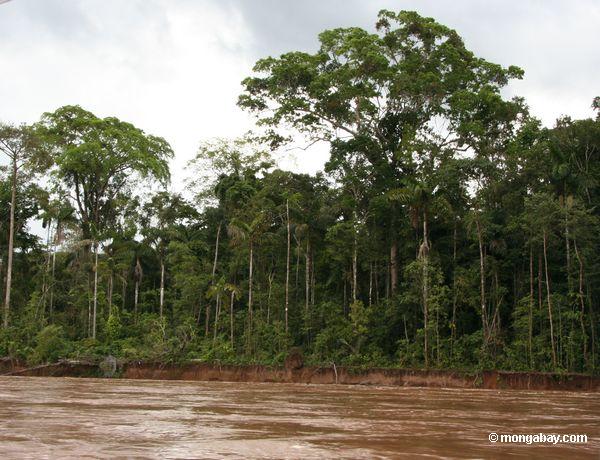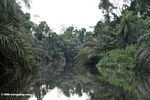The Amazon forest along the Tambopata River in Peru. Photo by: Rhett A. Butler.
A study last month in the journal Science argued that pre-Columbian peoples had little impact on the western and central Amazon, going against a recently composed picture of the early Amazon inhabited by large, sophisticated populations influencing both the forest and its biodiversity. The new study, based on hundreds of soil samples, theorizes that indigenous populations in much of the Amazon were tiny and always on the move, largely sticking to rivers and practicing marginal agriculture. However, the study raised eyebrows as soon as it was released, including those of notable researchers who openly criticized its methods and pointed out omissions in the paper, such as no mention of hundreds of geoglyphs, manmade earthen structures, found in the region.
“There is strong evidence of large settlements in eastern Amazonia, but our data point to different cultural adaptations in the central and western Amazon, which left vast areas with very little human imprint,” said co-author, Mark Bush, of the paper entitled “Sparse Pre-Columbian Human
Habitation in Western Amazonia” in a press release.
Based on 247 soil samples taken from 55 locations, the study found little evidence of charcoal, which is laid down when humans burn the rainforest. The team also looked for phytoliths, microscopic silica that is deposited after a plant dies, to find evidence of human-planted palm groves, but here too the soil samples came up short.
 Some researchers argue that the Amazon’s stunning biodiversity is in part a product of past indigenous civilizations. This is an unknown insect in Colombia. Photo by: Rhett A. Butler. |
“Natural fire (ignited by a force other than humans) is not a component of the western Amazonian landscape. Therefore, we interpreted charcoal presence to have mainly resulted from human ignitions,” Dolores Piperno, co-author of the paper and senior scientist with the Smithsonian Tropical Research Institute (STRI), explained to mongabay.com. “We do not draw conclusions about sophistication or extensiveness of human habitation based on the charcoal evidence alone, but rather the paired charcoal and phytolith results.”
But critics of study, including researchers Susanna Hecht and William Woods, contend that the study’s sample size was far too small to get a holistic view of a region around the size of India (i.e. covering approximately 3 million square kilometers).
“The number of sampled locations is pathetic for an extrapolation over such an enormous area. The authors claim that the sampling was random, but it seemingly is related to the ease of driving to each location. There is no background research on prior land-use in each sampled area and no null hypothesis,” Woods, an anthropologist at the University of Kansas, told mongabay.com.
Woods, Hecht, and eighteen other researchers have sent a letter to Science regarding the study, which notes that many of the sampled sites are highly clustered and sampling problems may have missed older charcoal even in these areas.
The researchers also contend that the focus on phytoliths may have missed the forest through the trees. While the discovery of phytoliths would show some evidence of man-influenced landscapes, the critics contend that it also misses some of the region’s most important crops.
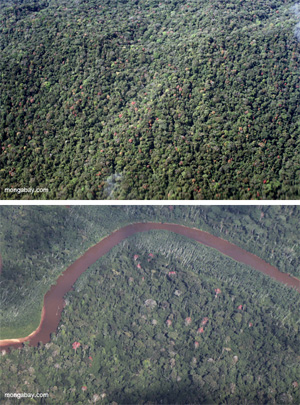 Amazon rainforest diversity. |
“It is worth noting that some 68% of domesticated Amazon crops are tree crops—some extraordinarily important ones like Brazil nut do not produce phytoliths, even though extensive anthropogenic groves were historically significant in Amazon economies, and are still today. Manioc, the Amazon staple, produces relatively few phytoliths,” the as yet unpublished letter to Science reads. In addition the letter notes that not all human-induced burning would leave behind charcoal in the soils.
But Piperno told mongabay.com that their paper was not an attempt to estimate total populations in the region.
“We do not try to estimate population size of western Amazonia. We only suggest, as our data do, that human impacts, and probably population sizes, are smaller in western Amazonia than in eastern Amazonia, and that pre-Columbian human impacts in western Amazonia in the areas we studied seem to have been strongest near the major rivers,” she says, adding that, “It’s important to point out that we do not extrapolate our results to encompass all of western Amazonia. However, because we approached this issue from a landscape-scale perspective, we feel that our data suggest patterns of human impacts in Amazonia that will be further investigated in the future.
Critiques of the study related to sample size and a blinkered focus may be valid, but such criticism does little more than dispute the evidence collected by Piperno and her colleagues. What about evidence that actually supports the image of large-scale, ecosystem-impacting populations, such as those found in eastern Amazonia?
Evidence for civilization?

Large-scale clearing of the Amazon, such as here for soy fields, has revealed hundreds of impressive geoglyphs. Photo by: Rhett A. Butler.
Was the western and central Amazon, in fact, inhabited by large civilizations of highly sophisticated gardeners and deeply spiritual peoples? Walls and Hecht say probably, arguing that the current paper overlooked two major lines of evidence: geoglyphs and historic literature.
As parts of the Amazon rainforest are cleared for cattle ranching and soy, archeologists are finding large earthen structures, known as geoglyphs, which they believe could only have been created by large, well-organized Amazonian civilizations.
“The clear implication of the geoglyphs is that the forest wasn’t there in its present form 500 years ago, but many, many people were,” Woods told mongabay.com. “I can’t imagine that the authors are so uninformed of the archaeological and historical literature; a more likely explanation is that they just ignored it.”
Woods believes the massive earth structures, not dissimilar from those discovered in the American Midwest, were likely ceremonial centers for sophisticated people, as there is no evidence of long-term human occupation at the sites or their use as defenses. To date, archeologists have uncovered over 300 such geoglyphs in the Amazon.
In response to the omissions of geoglyphs, co-author Piperno told mongabay.com that “the geoglyphs located in Acre, Brazil and Bolivia are indeed very interesting. They may eventually prove to be evidence of larger-scale pre-Columbian impacts, but our sampling locales weren’t within the known geoglyph zones and due to space constraints there was no room for a discussion of them.”
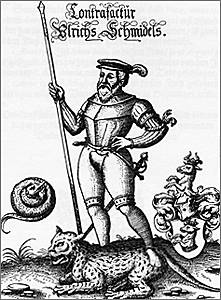 Woodcut from Ulrich Schmeidel’s book. |
Post-Columbian writings also provides interesting hints of large civilizations in the region, according to Hecht, a geographer at the University of California, Los Angeles and the founder of political ecology. Hecht points to a book written by a 16th Century German mercenary, Ulrich Schmeidel , which she says “describes a pretty complex world, one that was empty sometimes, but densely populated at others, with large roads on which he proposed four horse men could ride abreast. He also noted gold ornaments and ‘Andean Sheep’ by which he probably meant llamas. It’s an early description of this inland area, but many others follow.”
Schmeidel’s book also references tales of female warriors, which gave the rainforest its name from the Greek legend of the Amazons.
Jesuits in the region would also describe complex and warlike societies in the following decades. The ferocity and size of some of these tribes prevented missionaries from entering parts of the region according to Hecht.
“There is a very rich literature from many different sources that is part of the data set on land use history. While much of it is post contact, the ‘Jesuit century’ provided a lot of documentation by people who lived there,” she says, noting that even the world-famous Incan site, Machu Picchu, is technically in the western Amazon.
Current implications

Researchers are trying to understand the extent of past Amazonian civilizations, the ancestors of current indigenous peoples, such as this Huaorani guide in Yasuni National Park in the Ecuadorian Amazon. Photo by: Jeremy Hance.
According to both sides of the argument, more is at stake than simply the picture we have of past Amazonian societies. The Science study argues that their soil samples prove the Amazon rainforest is more a product of nature than human influence, refuting a recent theory which contends that human management was a primary player in the Amazon’s rich wildlife.
“The amazing biodiversity of the Amazon is not a byproduct of past human disturbance,” said lead author Crystal McMichael with the Florida Institute of Technology in a press release. “We also can’t assume that these forests will be resilient to disturbance, because many have never been disturbed, or have only been lightly disturbed in the past. Certainly there is no parallel in western Amazonia for the scale of modern disturbance that accompanies industrial agriculture, road construction, and the synergies of those disturbances with climate change.”
In other words, the Science study argues that a dearth of soil evidence for large-scale civilizations in the western and central Amazon is a persuasive argument for better conservation in the region today. To date, the Brazilian Amazon alone has lost around 580,000 square kilometers (224,000 square miles) largely to cattle ranching and soy. The massive rainforest continues to be threatened by industrialized agriculture, mining, roads, and dozens of planned hydroelectric dams.
“Some state that modern Amazonian biodiversity is more a result of prehistoric land use than longer-term factors ecologists and evolutionary biologists have documented,” co-author Piperno told mongabay.com “These statements can become a platform for arguing that Amazonian forests are resilient to disturbances, and have regenerated from high levels of historical anthropogenic modifications. We believe these are inappropriate assumptions at this time due to the paucity of empirical data from Amazonia at large, and based on our data, cannot be applied to the regions we studied.”
However, Hecht says that the presence of large and long-established indigenous populations in the Amazon shouldn’t be an excuse for deforestation, but rather a way to answer the question: who really owns the Amazon?
“Indigenous land rights often depend on the ability to argue for long term regional occupation and ideological and symbolic landscapes,” she explains. “By saying that upland forests had limited anthropogenic impact, [the researchers] essentially disenfranchise natives from land rights. Native reserves, as many studies have shown, are better in terms of conserving tropical forests than classic set asides. These questions of indigenous politics are not trivial and especially active now, in the age of REDD (Reducing Emissions from Deforestation and forest Degradation).”
For Woods, the presence of large civilizations across the Amazon would imply that management of the rainforest could continue on a different, and better, track than the current state of affairs, which vacillates between deforestation and protected areas.
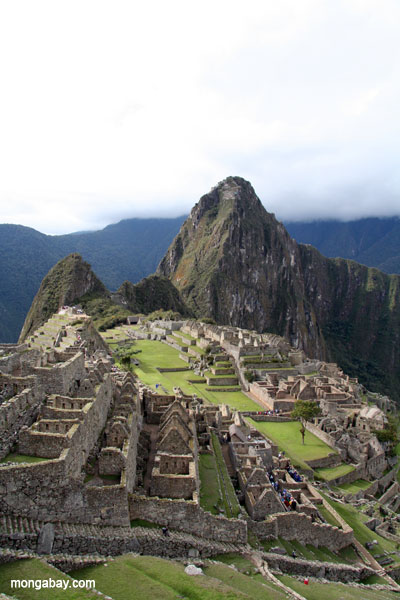 Machu Picchu, Peru Photo by R. Butler |
“If many people lived sustainably in western Amazonia in the past as the growing body of evidence makes clear, then by duplicating their practices many people can live there sustainably now.” he explains. “These practices included soil modification, orchards, agroforestry, trade, and a long-term view of enhancing their environment.”
But Piperno contends that “without empirical data, what is found at a relatively few archaeological sites cannot be extrapolated across an area almost the size of the continental United States. Within both the scholarly literature and mass media outlets, a number of scholars have proclaimed that ‘much of’ or ‘most’ of Amazonia was a completely transformed landscape before Europeans arrived.”
It’s interesting to note, however, that Hecht also contends that Piperno’s study is guilty of extrapolation: using soil samples from a few dozen sites to draw conclusions for a massive and complex region.
“Amazonian occupation is heterogeneous and was in the past and there is much we don’t know about its history,” she says. “But extrapolating from a very limited sample size, and defining away the sites that don’t fit the hypothesis is pretty questionable.”
Whatever civilizations thrived in the Amazon when Columbus arrived, most of them fell within a few centuries of conquest. Disease, brought by the European adventurers, tore through indigenous populations; survivors were killed off or marginalized by brutal colonization, massacres, slavery, and almost constant warfare. This holocaust was probably unprecedented in history, and certainly depopulated the Amazon rainforest, just as it did the entirety of the American continents. However, just because large populations once thrived in the Amazon, at least in the eastern section, its clear from all sides that this shouldn’t be an excuse for the industrialized destruction of the rainforest, as it is currently being practiced, but rather for a deeper analysis and debate into how to keep the ecosystem thriving in an age of massive— biodiversity loss and climate change.
CITATION: C. H. McMichael, D. R. Piperno, M. B. Bush, M. R. Silman, A. R. Zimmerman, M. F. Raczka, L. C. Lobato. Sparse Pre-Columbian Human
Habitation in Western Amazonia. Science. 2012. Vol 336.
Related articles
Humans drove rainforest into savannah in ancient Africa
(02/09/2012) Three thousand years ago (around 1000 BCE) several large sections of the Congo rainforest in central Africa suddenly vanished and became savannah. Scientists have long believed the loss of the forest was due to changes in the climate, however a new study in Science implicates an additional culprit: humans. The study argues that a migration of farmers into the region led to rapid land-use changes from agriculture and iron smelting, eventually causing the collapse of rainforest in places and a rise of grasslands. The study has implications for today as scientists warn that the potent combination of deforestation and climate change could flip parts of the Amazon rainforest as well into savannah.
Evidence mounts that Maya did themselves in through deforestation
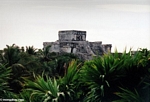
(12/08/2011) Researchers have garnered further evidence for a smoking gun behind the fall of the great Maya civilization: deforestation. At the American Geophysical Union (AGU) conference, climatologist Ben Cook presented recent research showing how the destruction of rainforests by the Mayan ultimately led to declines in precipitation and possibly civilization-rocking droughts. While the idea that the Maya may have committed ecological-suicide through deforestation has been widely discussed, including in Jared Diamond’s popular book Collapse, Cook’s findings add greater weight to the theory.
Pre-Colombian Amazonians lived in sustainable ‘urban’ society
(08/28/2008) Researchers have uncovered new evidence to support the controversial theory that parts of the Amazon were home to dense “urban” settlements prior to the arrival of Europeans in the 15th century. The study is published this Friday in the journal Science. Conducting archeological excavations and aerial imagery across a number of sites in the Upper Xingu region of the Brazilian Amazon, a team of researchers led by Michael Heckenberger found evidence of a grid-like pattern of 150-acre towns and smaller villages, connected by complex road networks and arranged around large plazas where public rituals would take place. The authors argue that the discoveries indicate parts of the Amazon supported “urban” societies based around agriculture, forest management, and fish farming.
Heavily-populated Amazon was decimated by old world disease
(06/09/2008) Ecologists and archaeologists agree that when Columbus struck the Americas in 1492 everything changed, but questions persist over the kind of world Columbus and his followers would soon transform. Recently the state of the pre-Columbian Amazon has been under increasing debate among scientists across numerous fields. In a lecture given at the ATBC conference (Association of Tropical Biology and conservation) in Paramaribo, Suriname, Dr. Francis Mayle weighed in on the debate.
Ancient Amazon fires linked to human populations
(02/20/2008) Analysis of soil charcoal in South America confirms that from a historical perspective, fire is rare in the Amazon rainforest, but when it does occur, it appears linked to human activities. The research, published in Philosophical Transactions of the Royal Society B, is based on dating of soil carbon, which provides a good indication of when fires occurred in Amazonia, according to lead author Mark Bush, head of the Department of Biology at Florida Institute of Technology.
Amazon rainforest fires date back thousands of years
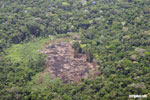
(03/14/2007) Fires are nothing new to the Amazon reports a study published in the journalBiotropica. Analyzing soils in the eastern Amazon, a team of scientists led by David S. Hammond of NWFS Consulting, has found evidence of forest fires dating back thousands of years. While the origin of these fires is unclear, the authors propose intriguing scenarios involving pre-Colombian human populations and ancient el Nino events which could have so dried rainforest areas that they became more prone to forest fires.
Pre-Colombian Amazon rainforest not heavily populated
(03/06/2007) Much of the Amazon rainforest was not heavily populated by pre-Colombian indigenous cultures argues a new paper published in the journal Philosophical Transactions of the Royal Society B: Biological Sciences. The work challenges an increasingly accepted theory — popularized in Charles C. Mann’s 1491: ‘New Revelations of the Americas Before Columbus’ — the Amazon supported dense, sedentary populations prior to the arrival of Europeans.
